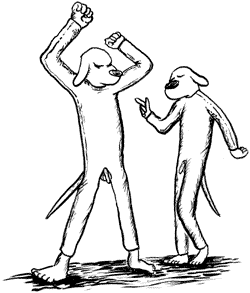ART OR IDIOCY?
I Put on the TV to Feel More Connected to the World
I was in New York recently and saw two amazing shows featuring work in video, as opposed to the ones I’m accustomed to seeing — horrible video exhibitions.
In Paula Cooper’s museum-quality space was Christian Marclay’s “Video Quartet.” In this enormous space there are four screens and four projected DVDs. It was an audio and visual symphony composed of clips running the gamut of film history. Aside from mirroring, no effects have been applied to the images — all the cuts are straight edits. It is through the matching of sounds, ideas, and images that completely disparate bits are blended together. It is a complete piece of music and non-narrative cinema, full of vignettes and themes. There are moments of humor and melancholy, beauty and complexity. It is fast paced and thoughtful. If every movie and song ever made were compiled into a huge database and made available for viewing, this is how it would feel to see it all at once. Everything is interconnected and chaotic, but also poignant and touching. Out of the cacophony arises a profound sense of order.

A few blocks away at the Dia Center is an installation of “Manu’s Spleen,” Rosemarie Trockel’s video suite. The videos are accompanied by several metallic wall pieces, and some artists’ books, all of which are collectively exhibited as “Spleen.” These temporary walls have sculptures on them in the form of patterned grids of monochromatic metal panels that sweep and move like oceans, tricking the eye with optical effects. On the back of each is projected an installment of the “Manu’s Spleen” series.
Rosemarie Trockel is one of those artists who’s hard to pin down. Her work is so varied and different; you’re constantly having to remind yourself that it’s all done by the same person. Each piece seems to function in a unique way. The formalist wall sculptures, with titles like “Rancho Deluxe” and “Treasure of the Sierra Madre,” form a passage of metal, behind which are the non-sequential vignettes of “Manu’s Spleen,” a character we never meet.
The title, “Manu’s Spleen,” seems to suggest a concept, and since this is a German artist, I imagine it translates to something like “humanity’s struggle.” Except that would be something like “manner kampf.” It’s a funny title, and isn’t the spleen a part of the body? So maybe it is “Humanity’s Spleen,” as opposed to “heart” or “soul.”
Of Manu’s five spleens, one has left a lasting impression on me. In “Manu’s Spleen 4,” we see the most complex episode of the series. Two naked men tow a wagon in a circle, on which rides Joan of Arc, a fashionable older woman. There is also Jackie O moving a big fat cannon. The young men are very skinny and creepy and just when you think, “What is it with Germans and lanky naked boys?” you realize they are wearing skin-like suits, complete with tiny, limp, stuffed animal-type wieners.
Joan of Arc is depressed because she can’t find anything good on her radio. Two disembodied blondes float in the foreground, mouthing all the things that come over the radio. A groovy ditty comes on and the naked guys start dancing, then one jumps down the barrel of the cannon, which Jackie O proceeds to polish. The fashionable woman checks herself out in the reflection of a pot, and some more channels change. We hear other voices in foreign languages and then the news of Kennedy’s assasination, which Jackie O doesn’t seem to care about, as she continues to polish the cannon.
Then John Lennon’s “Imagine” comes on the radio, followed by more groovy tunes. Then the second naked guy goes down the cannon. The fashionable woman starts pulling the wagon and the procession continues in circles.
These characters find themselves in limbo, perhaps on the long return from a lost battle. They are all symbols that signify nothing: Jackie, the fat cannon, Joan of Arc, the severe fashion victim. Naked man-boys. The radio, scanning the airwaves of time. Joan of Arc is searching for a meaning, or her bearings, in the endless radio waves bouncing around through history. Nothing happens, so they continue in circles. It is absurd and incongruent imagery that is jarring and captivating. It seeks to imply and confuse rather than state anything.
Both Marclay and Trockel seem to be taking up the tasks of making sense of recent history in their pieces. Marclay has chosen to sift through source material and collage it all together in a symphonic expression. Trockel has abstracted events in to symbolic gestures, war, death, loss, and peace, and then peppered in specific references, like the Kennedy assassination and John Lennon. Both are successful and captivating routes of exploration.
Illustration by Erik Wenzel